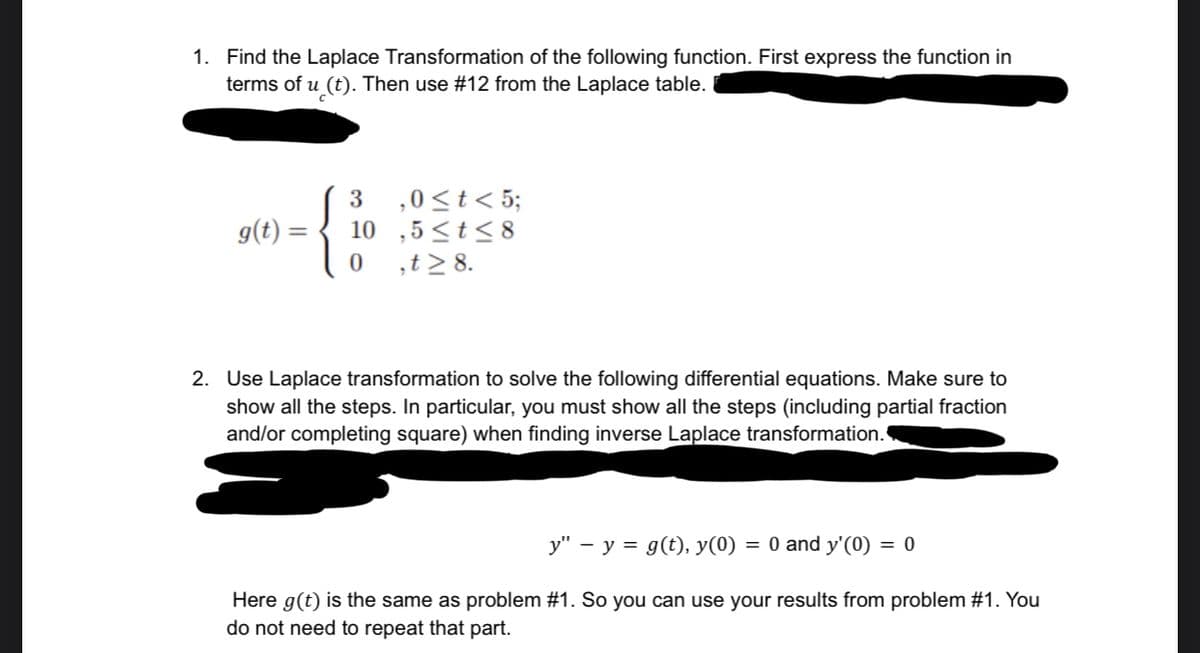1. Find the Laplace Transformation of the following function. First express the function in terms of u (t). Then use #12 from the Laplace table. g(t) = 3 ,0 ≤ t < 5; 10,5≤t≤8 0 ,t≥ 8. 2. Use Laplace transformation to solve the following differential equations. Make sure to show all the steps. In particular, you must show all the steps (including partial fraction and/or completing square) when finding inverse Laplace transformation. y" - y = g(t), y(0) = 0 and y'(0) = 0 Here g(t) is the same as problem #1. So you can use your results from problem #1. You do not need to repeat that part.
1. Find the Laplace Transformation of the following function. First express the function in terms of u (t). Then use #12 from the Laplace table. g(t) = 3 ,0 ≤ t < 5; 10,5≤t≤8 0 ,t≥ 8. 2. Use Laplace transformation to solve the following differential equations. Make sure to show all the steps. In particular, you must show all the steps (including partial fraction and/or completing square) when finding inverse Laplace transformation. y" - y = g(t), y(0) = 0 and y'(0) = 0 Here g(t) is the same as problem #1. So you can use your results from problem #1. You do not need to repeat that part.
Linear Algebra: A Modern Introduction
4th Edition
ISBN:9781285463247
Author:David Poole
Publisher:David Poole
Chapter4: Eigenvalues And Eigenvectors
Section4.6: Applications And The Perron-frobenius Theorem
Problem 69EQ: Let x=x(t) be a twice-differentiable function and consider the second order differential equation...
Related questions
Question
please indicate what number in the laplace table you are using. Please write all work neat and clearly.

Transcribed Image Text:1. Find the Laplace Transformation of the following function. First express the function in
terms of u (t). Then use #12 from the Laplace table.
g(t) =
3 ,0 ≤ t < 5;
10,5≤t≤8
0 ,t> 8.
2. Use Laplace transformation to solve the following differential equations. Make sure to
show all the steps. In particular, you must show all the steps (including partial fraction
and/or completing square) when finding inverse Laplace transformation.
y" - y = g(t), y(0) = 0 and y'(0) = 0
Here g(t) is the same as problem #1. So you can use your results from problem #1. You
do not need to repeat that part.
Expert Solution
This question has been solved!
Explore an expertly crafted, step-by-step solution for a thorough understanding of key concepts.
Step by step
Solved in 4 steps with 3 images

Recommended textbooks for you

Linear Algebra: A Modern Introduction
Algebra
ISBN:
9781285463247
Author:
David Poole
Publisher:
Cengage Learning

Linear Algebra: A Modern Introduction
Algebra
ISBN:
9781285463247
Author:
David Poole
Publisher:
Cengage Learning